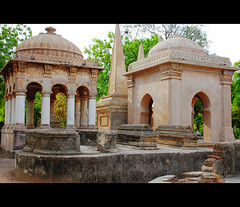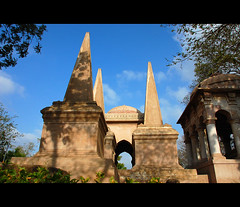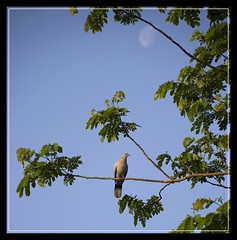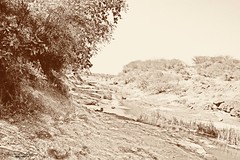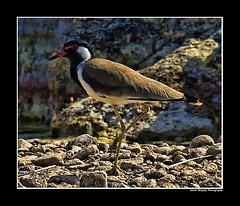Saturday, November 20, 2010
Friday, November 19, 2010
Monday, October 18, 2010
Saturday, September 25, 2010
Friday, September 17, 2010
Saturday, September 04, 2010
Monday, June 28, 2010
Wednesday, June 09, 2010
Monday, June 07, 2010
Dutch Tomes
Dutch Tomes
Laid to rest away from home
In the 17th and 18th centuries, Dutch traders from Holland came to Gujarat. They used to trade in cotton cloth, yarn and indigo. Surat was the main centre of their trade, but a small number lived in Ahmedabad. Some of them died here. These tombs were built in their memory. The stru...ctures reflect a mix of architectural styles. The inscriptions on some of the tombs are in Dutch and Latin. Ahmedabad had at least one another Dutch building, but it no longer exists. This was the Dutch Haveli on Gandhi Road.
Sad that none of this information is available in travel guides about Ahmedabad or in Wikipedia.
Laid to rest away from home
In the 17th and 18th centuries, Dutch traders from Holland came to Gujarat. They used to trade in cotton cloth, yarn and indigo. Surat was the main centre of their trade, but a small number lived in Ahmedabad. Some of them died here. These tombs were built in their memory. The stru...ctures reflect a mix of architectural styles. The inscriptions on some of the tombs are in Dutch and Latin. Ahmedabad had at least one another Dutch building, but it no longer exists. This was the Dutch Haveli on Gandhi Road.
Sad that none of this information is available in travel guides about Ahmedabad or in Wikipedia.
Dutch Cemetery Building
Dutch Tomes
Laid to rest away from home
In the 17th and 18th centuries, Dutch traders from Holland came to Gujarat. They used to trade in cotton cloth, yarn and indigo. Surat was the main centre of their trade, but a small number lived in Ahmedabad. Some of them died here. These tombs were built in their memory. The structures reflect a mix of architectural styles. The inscriptions on some of the tombs are in Dutch and Latin. Ahmedabad had at least one another Dutch building, but it no longer exists. This was the Dutch Haveli on Gandhi Road.
Sad that none of this information is available in travel guides about Ahmedabad or in Wikipedia.
Laid to rest away from home
In the 17th and 18th centuries, Dutch traders from Holland came to Gujarat. They used to trade in cotton cloth, yarn and indigo. Surat was the main centre of their trade, but a small number lived in Ahmedabad. Some of them died here. These tombs were built in their memory. The structures reflect a mix of architectural styles. The inscriptions on some of the tombs are in Dutch and Latin. Ahmedabad had at least one another Dutch building, but it no longer exists. This was the Dutch Haveli on Gandhi Road.
Sad that none of this information is available in travel guides about Ahmedabad or in Wikipedia.
Thursday, April 08, 2010
Sunday, February 21, 2010
Zanzri Waterfall Entrance
Camera: Nikon D40
Exposure: 0.006 sec (1/160)
Aperture: f/8.0
Focal Length: 18 mm
ISO Speed: 200
Exposure Bias: 0 EV
Flash: No Flash
Exposure: 0.006 sec (1/160)
Aperture: f/8.0
Focal Length: 18 mm
ISO Speed: 200
Exposure Bias: 0 EV
Flash: No Flash
Wednesday, February 10, 2010
Tuesday, January 19, 2010
Safety Accessories For A Safe Motorcycle Trip or Commute
Most of us love riding a motorcycle, but always overlook the safety aspects of riding. In India, we find most of our compatriots giving safety features a miss and indulge in unsafe riding, whereas riders in foreign countries ensure that they have proper protection before mounting on their rides. A proper and certified riding gear is a necessary and intrinsic part of motorcycling along with good riding skills and a well-maintained motorcycle. Riding on two-wheels, while being exposed to weather and sans protection from contact with either the road or other objects in case of a fall or an accident, the riding gear becomes the last line of defense.
1) Helmet :-
A helmet acts as a protector of your brain (remember the Gladiators wearing one or most warriors!). Its hard outer shell made of propriety plastics, strong polymers or even fiber-glass can protect the head from any object that can penetrate the helmet on impact and hit the skull inside. A light, hard and strong shell that resists deformation makes for a good helmet.
In choosing a helmet, first and foremost look for either BIS (in case of Indian make helmets) or DOT approval (in case of imported ones). These ‘certification’ marks ensure that the helmet meets with certain rigorous and standardized safety standards and shall perform as expected and promised.
..::.. SPECIAL LOOKOUTS ..::..
• Always prefer a full face helmet to an open face one as the former obviously provides better protection.
• Look for as wide and eye-port as you can get, especially in the peripheral region.
• Prefer a clear visor and look for scratch-resistant hard plastic ones.
• A double-D ring fastener is far better than a ‘click’ type fastener for the chin strap.
• To check for fit, wear the helmet, hold it from outside and try to move your head inside side to side. A well-fitting helmet should allow very little head movement inside it. One that allows the head to move is loose and will not protect the skull well on impact.
A good quality Helmet cost - INR 2500/- with changeable inner pads, air ducts to circulate air inside and washable inner linings & neck pads.
2) Riding Jacket :-
Riding jackets, with protective hard re-enforcements at specific places (like elbow joints, shoulders, back and chest areas) protect these areas from abrasion and injury during a fall or skid. The riding jacket will not be able to save a bone from breaking if the fall is that bad, but certainly the skin gets protected very well.
Jackets also protect the rider from the natural elements like hot, cold or rainy conditions. When choosing a jacket, again look for the safety standards that it meets with. Look for good ventilation in warm weather. Or, that prevents water and wind penetration in cold conditions. Zippered fronts with a flap over the zipper, are far more effective wind protectors that buttoned ones.
A good quality Riding Jacket costs - INR 5500/- with protection pads on shoulders, elbows, back and have removable inner linings for variable climates.
3) Riding Pants :-
These are again used to protect from abrasion and save the joints especially from injury through impact with small hard objects like the riding jackets. As with jackets, buy pants according to the temperatures and humidity you expect for most of your rides.
A relatively cheaper alternate to full riding pants are knee-guards or knee protectors. The knee, elbow and ankle joints suffer the most in case of a fall from a moving motorcycle and the knee-guards provide strategic protection to the vulnerable knee/elbow joint area. Made of hard polymers, either with a flexible hinge or pivoted to provide for knee rotation, these should be a tight fit around the leg to be useful.
A good quality Riding Pants costs - INR 4500/- with knee protection pads. A Knee Protector or pad will cost - INR 2500/- and can be worn above any jeans or cargo pants.
4) Gloves :-
Protecting the hands, both from injury and weather, is a prime concern for any bike rider. Full fingered gloves are the best, should have a good fit and provide the best ‘feel’ of the controls through it. Leather again is the best but good synthetics with re-enforcing inserts over knuckles and finger joints protect equally well. Double stitched seams provide for greater durability and better sealing in case of water-proofing. The inside of the glove should be of a non-slip materiel to provide good grip over the handle-bar mounted controls. And it should not slip even when wet. A gauntlet or wrist cover type glove is in fact the best design as it gives the best fit for the glove.
A pair of full fingered gloves costs - INR 2500/- and has metal, rubber or polymer knuckles and finger protection.
5) Footwear :-
Feet need to be protected not just from abrasion but also from potential injury when caught under a heavy fallen motorcycle with some parts that would be uneasily hot. Boots need to be at least ankle high with a heavy sole and a re-enforced toe and heel area. Thick padded material for the upper and a strong and thick sole are mandatory for a good riding shoe. The sole should also provide good grip over the footrests even when wet.
A good quality Riding Shoes costs - INR 6000/- with up to shin protection and metal or polymer protection for the toe and a heavy grippy sole.
6) Rain Suits :-
Apart from good wet riding tires, a rider needs protection from the rain or drizzle. A wet rider is a distracted and uncomfortable rider. So wear rain protection. A riding jacket and pant is usually rain proof, but a rain over suit is better. Buy ones that are bright in color and have a reflective coating for better visibility on the road and are a comfortable fit over and above your regular riding gear.
A good Rain Suit costs - INR 550/- and is similar to the raincoat or rain overalls that's available in stores during the rainy season.
7) Balaclava :-
This is not a mandatory part of safety gear, but helps in a number of ways, especially the cotton variety. It helps in snugly fitting the helmet and absorbs sweat before it gets to the inside liner of the helmet and also helps keep the nose and ears warm during a cold weather ride.
A good quality Balaclava costs - INR 350/- and saves the face from stinging winds & keeps your costly helmet from getting soggy from sweating.
"Be Safe & Ride Safe"
* NOTE: All the prices are the minimum sale price in India for the best available accessory in its class and a requirement for motorcycle riders sans the bike's capacity.
1) Helmet :-
A helmet acts as a protector of your brain (remember the Gladiators wearing one or most warriors!). Its hard outer shell made of propriety plastics, strong polymers or even fiber-glass can protect the head from any object that can penetrate the helmet on impact and hit the skull inside. A light, hard and strong shell that resists deformation makes for a good helmet.
In choosing a helmet, first and foremost look for either BIS (in case of Indian make helmets) or DOT approval (in case of imported ones). These ‘certification’ marks ensure that the helmet meets with certain rigorous and standardized safety standards and shall perform as expected and promised.
..::.. SPECIAL LOOKOUTS ..::..
• Always prefer a full face helmet to an open face one as the former obviously provides better protection.
• Look for as wide and eye-port as you can get, especially in the peripheral region.
• Prefer a clear visor and look for scratch-resistant hard plastic ones.
• A double-D ring fastener is far better than a ‘click’ type fastener for the chin strap.
• To check for fit, wear the helmet, hold it from outside and try to move your head inside side to side. A well-fitting helmet should allow very little head movement inside it. One that allows the head to move is loose and will not protect the skull well on impact.
A good quality Helmet cost - INR 2500/- with changeable inner pads, air ducts to circulate air inside and washable inner linings & neck pads.
2) Riding Jacket :-
Riding jackets, with protective hard re-enforcements at specific places (like elbow joints, shoulders, back and chest areas) protect these areas from abrasion and injury during a fall or skid. The riding jacket will not be able to save a bone from breaking if the fall is that bad, but certainly the skin gets protected very well.
Jackets also protect the rider from the natural elements like hot, cold or rainy conditions. When choosing a jacket, again look for the safety standards that it meets with. Look for good ventilation in warm weather. Or, that prevents water and wind penetration in cold conditions. Zippered fronts with a flap over the zipper, are far more effective wind protectors that buttoned ones.
A good quality Riding Jacket costs - INR 5500/- with protection pads on shoulders, elbows, back and have removable inner linings for variable climates.
3) Riding Pants :-
These are again used to protect from abrasion and save the joints especially from injury through impact with small hard objects like the riding jackets. As with jackets, buy pants according to the temperatures and humidity you expect for most of your rides.
A relatively cheaper alternate to full riding pants are knee-guards or knee protectors. The knee, elbow and ankle joints suffer the most in case of a fall from a moving motorcycle and the knee-guards provide strategic protection to the vulnerable knee/elbow joint area. Made of hard polymers, either with a flexible hinge or pivoted to provide for knee rotation, these should be a tight fit around the leg to be useful.
A good quality Riding Pants costs - INR 4500/- with knee protection pads. A Knee Protector or pad will cost - INR 2500/- and can be worn above any jeans or cargo pants.
4) Gloves :-
Protecting the hands, both from injury and weather, is a prime concern for any bike rider. Full fingered gloves are the best, should have a good fit and provide the best ‘feel’ of the controls through it. Leather again is the best but good synthetics with re-enforcing inserts over knuckles and finger joints protect equally well. Double stitched seams provide for greater durability and better sealing in case of water-proofing. The inside of the glove should be of a non-slip materiel to provide good grip over the handle-bar mounted controls. And it should not slip even when wet. A gauntlet or wrist cover type glove is in fact the best design as it gives the best fit for the glove.
A pair of full fingered gloves costs - INR 2500/- and has metal, rubber or polymer knuckles and finger protection.
5) Footwear :-
Feet need to be protected not just from abrasion but also from potential injury when caught under a heavy fallen motorcycle with some parts that would be uneasily hot. Boots need to be at least ankle high with a heavy sole and a re-enforced toe and heel area. Thick padded material for the upper and a strong and thick sole are mandatory for a good riding shoe. The sole should also provide good grip over the footrests even when wet.
A good quality Riding Shoes costs - INR 6000/- with up to shin protection and metal or polymer protection for the toe and a heavy grippy sole.
6) Rain Suits :-
Apart from good wet riding tires, a rider needs protection from the rain or drizzle. A wet rider is a distracted and uncomfortable rider. So wear rain protection. A riding jacket and pant is usually rain proof, but a rain over suit is better. Buy ones that are bright in color and have a reflective coating for better visibility on the road and are a comfortable fit over and above your regular riding gear.
A good Rain Suit costs - INR 550/- and is similar to the raincoat or rain overalls that's available in stores during the rainy season.
7) Balaclava :-
This is not a mandatory part of safety gear, but helps in a number of ways, especially the cotton variety. It helps in snugly fitting the helmet and absorbs sweat before it gets to the inside liner of the helmet and also helps keep the nose and ears warm during a cold weather ride.
A good quality Balaclava costs - INR 350/- and saves the face from stinging winds & keeps your costly helmet from getting soggy from sweating.
"Be Safe & Ride Safe"
* NOTE: All the prices are the minimum sale price in India for the best available accessory in its class and a requirement for motorcycle riders sans the bike's capacity.
Saturday, January 09, 2010
Subscribe to:
Posts (Atom)









